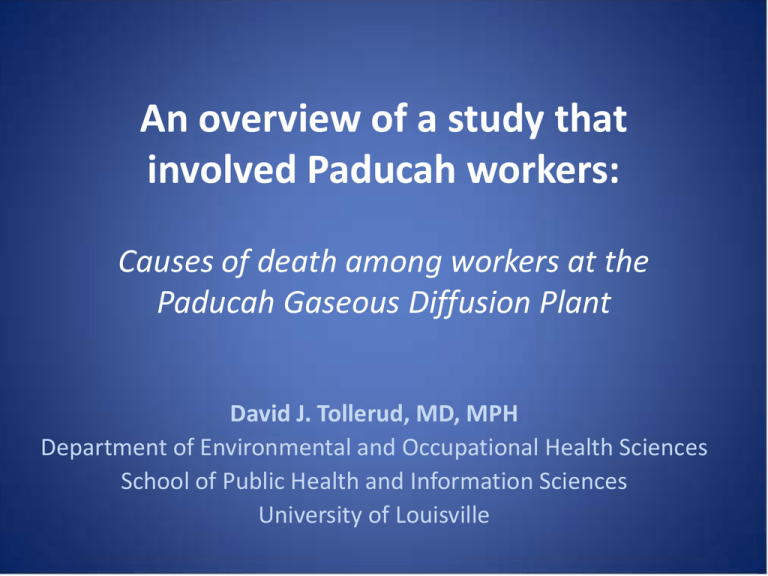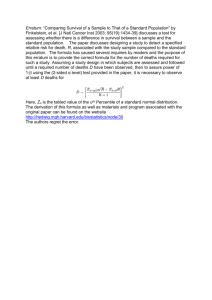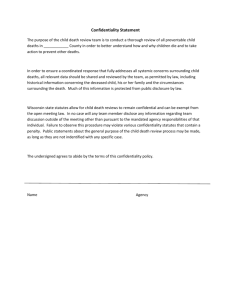An overview of a study that involved Paducah workers:
advertisement

An overview of a study that involved Paducah workers: Causes of death among workers at the Paducah Gaseous Diffusion Plant David J. Tollerud, MD, MPH Department of Environmental and Occupational Health Sciences School of Public Health and Information Sciences University of Louisville Purpose of meeting • Talk with Paducah workers about a recent study that may have included them – Give you an overview about the study and results – Answer any questions you may have – Let you know where to go if you have other questions Why we did this study: • Paducah Gaseous Diffusion Plant enriches uranium for nuclear reactors • Employee concern that radiation and other chemicals may have affected their health Why we did this study: • We did this study to find out if workers had an increased death rate compared to the U.S. population. – In other words, we wanted to know if more workers had died from certain illnesses compared to what would be expected among the U.S. population. – This would help us better understand if work hazards may have affected workers’ health. Who did the study: • University of Louisville • University of Kentucky • University of Cincinnati The National Institute for Occupational Safety and Health (NIOSH) funded the project. Who was in the study: • 6,820 men and women worked 30+ days at the plant between September 1952 and December 2003 • We included 6,759 of these workers who had completed work and personal information • We did not include independent contractors How the study was done: • The study was done using personnel and available radiation exposure records. • Using death certificates, we found workers who are now deceased. • Death certificates were also used to find the cause of death. How the study was done: • We then compared the number of deaths from each cause to what would be expected in the U.S. population. • We did not do searches for workers who were sick or recovered from an illness. This is because the type of study done only looks at causes of death, it does not assess incidence of disease. How the study was done: • We also looked to see if other things influenced death rates among workers: – Different jobs – Levels of radiation exposure – Exposure to toxic metals: Arsenic, beryllium, chromium, nickel, and uranium What we found: • First, we looked to see if there were a higher number of deaths overall. • We found a lower total number of deaths among these workers compared to the U.S. population. This is known by occupational health researchers as the “healthy worker effect”. – Overall, 1,638 workers died out of the 6,759 in the study (~25%). – This is less than the 2,253 that would have been expected in the U.S. population during the same time. What we found: • Second, we looked to see if there were a higher number of deaths related to cancer overall (all types of cancer combined). • No increase was found in the total number of cancer deaths among these workers compared to the U.S. population. – We found 461 workers died from a type of cancer. – This is less than the 592 we would have expected in the U.S. population. What we found: • Then we looked at specific causes of death to see if certain causes of death were higher among workers. • In looking at specific causes, we found slightly more deaths from lymphatic and bone marrow cancers than expected. – These cancers included: • Leukemia (24 deaths, ~21 would have been expected) • Non-Hodgkin’s lymphoma (32 deaths, 22 expected) What we found: • When looking at job titles, plant security workers had higher rates of death overall compared to the rest of the study population. – Deaths from non-Hodgkin’s lymphoma were at higher rates than the rest of the workers • Non-Hodgkin’s lymphoma accounted for 5 deaths among security workers What we found: • We did not find any patterns of increased deaths when we analyzed exposures to radiation and metals. What this means: • Based on our study, we found no increase in the overall deaths among workers compared to the U.S. population. • We did find a slightly higher rate of death from lymphatic and bone marrow cancers. – Your risk of dying from these cancers is still low. Questions? • If you have questions or want more information, you may contact: David Tollerud, MD, MPH david.tollerud@louisville.edu


